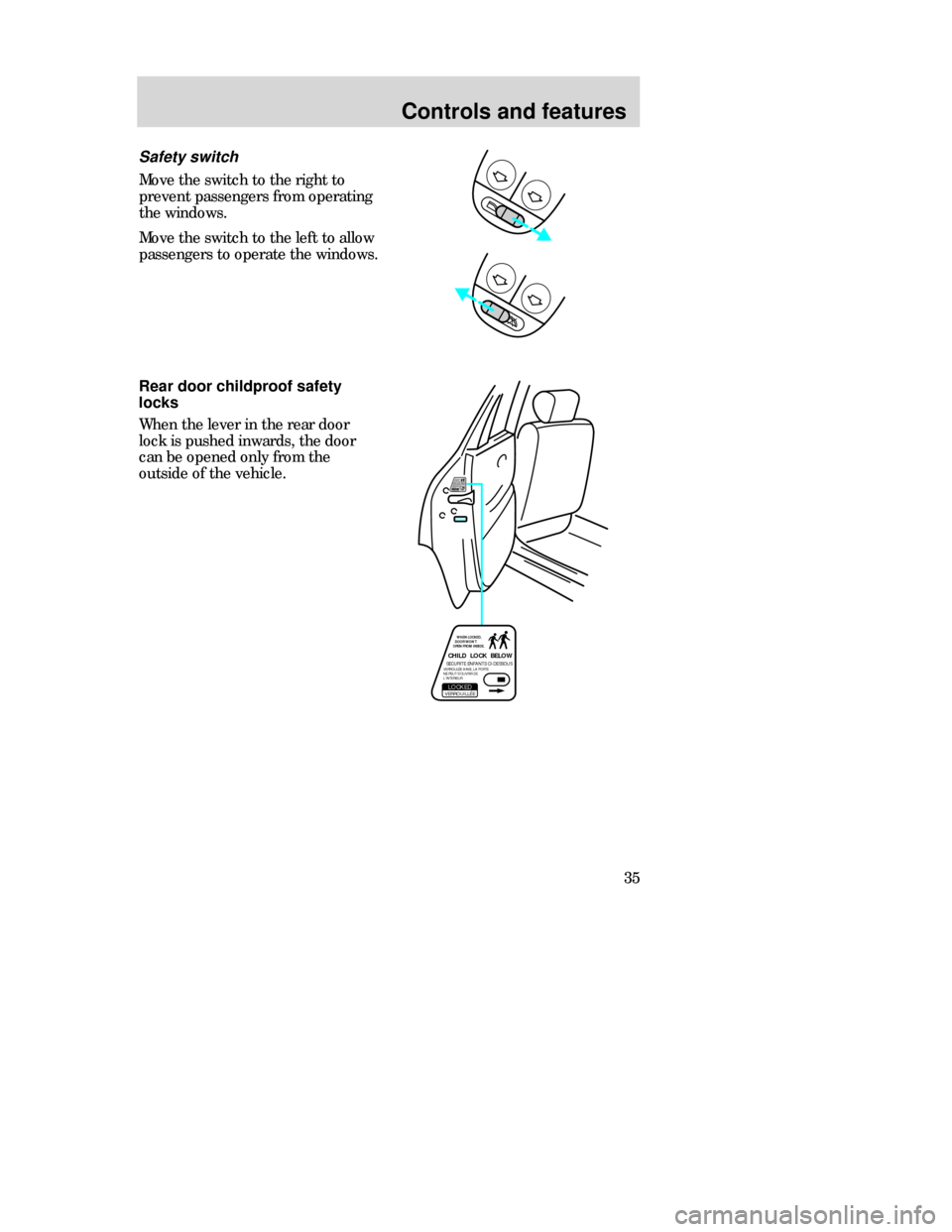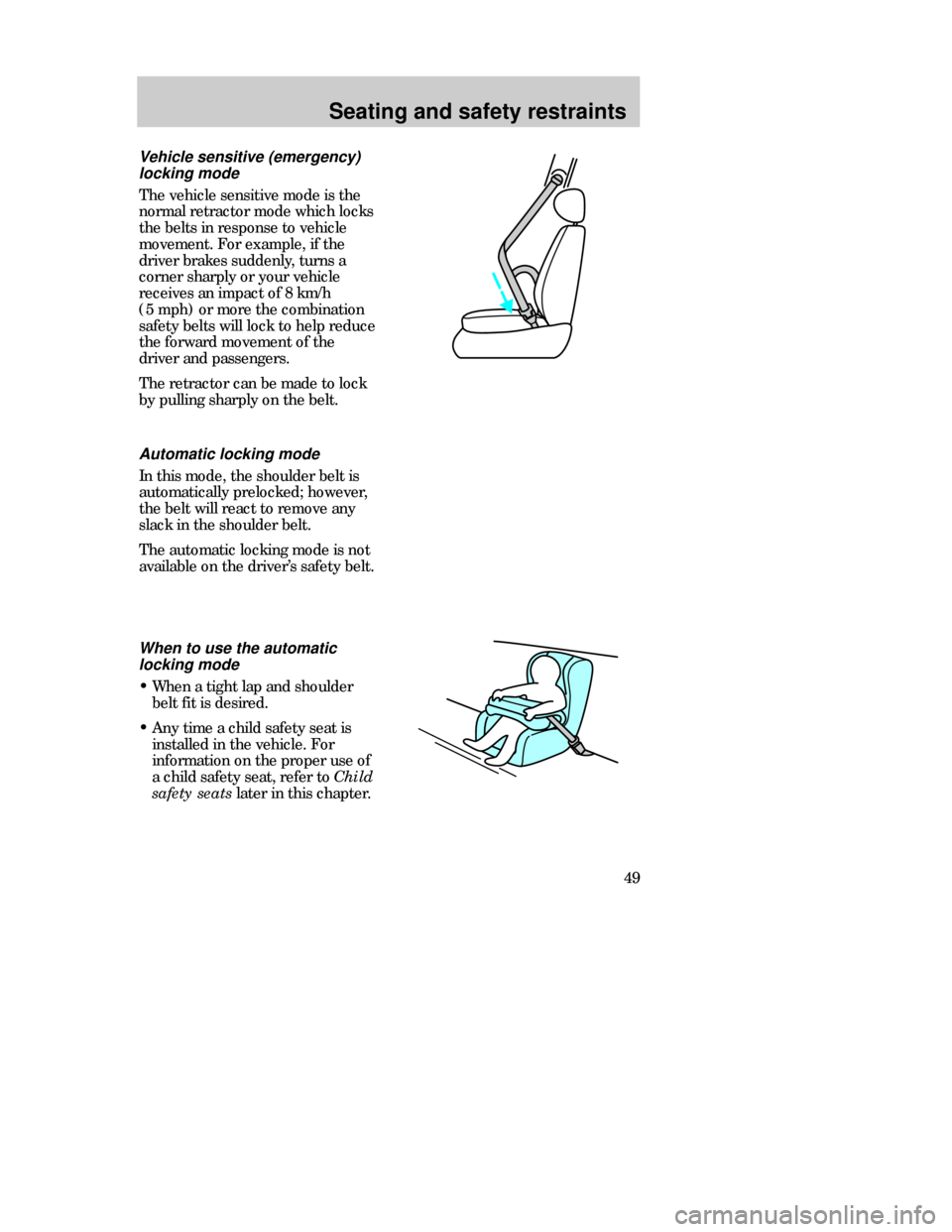child lock Mercury Mystique 1998 Owner's Manuals
[x] Cancel search | Manufacturer: MERCURY, Model Year: 1998, Model line: Mystique, Model: Mercury Mystique 1998Pages: 196, PDF Size: 1.65 MB
Page 35 of 196

Controls and features
35
Safety switch
Move the switch to the right to
prevent passengers from operating
the windows.
Move the switch to the left to allow
passengers to operate the windows.
CHILD LOCK BELOWSECURITE ENFANTS CI-DESSOUS´VERROUILLEE,LOCKED WHEN LOCKED,
DOOR WON`T
OPEN FROM INSIDE.´VERROULEE AINSI, LA PORTE
NE PEUT S´OUVRIR DE
L´INTERIEUR.
CHILD LOCK BELOWSECURITE ENFANTS CI-DESSOUS´
VERROUILLEE,LOCKED
WHEN LOCKED,
DOOR WON`T
OPEN FROM INSIDE.
´VERROULEE AINSI, LA PORTE
NE PEUT S´OUVRIR DE
L´INTERIEUR.
Rear door childproof safety
locks
When the lever in the rear door
lock is pushed inwards, the door
can be opened only from the
outside of the vehicle.
CDW IIIC3Cont en MM 5/15/97 7:45 PM Page 35
Page 46 of 196

Seating and safety restraints
46
Folding rear seats (if equipped)
Pull the release knob located in the
luggage compartment. Fold down
the seat. The seatback cannot be
released while the built-in childseat
(if equipped) is open.
If you are carrying objects that
might damage the center rear
three-point safety belt, you can
unbuckle the end of the belt from
the small buckle on the seat
cushion and let the retractor reel it
up. Reconnect the belt tongue to
the buckle when you fold the seat
back up.
To raise the rear seatback, push the
seatback upward until it locks in
place. Make sure it is firmly latched
by pushing forward and back on it.
Check to see that the seat
and seatback are latched
securely in position. Keep luggage
area free of objects that would
prevent proper engagement.
CDW IIID Seat en MM 5/15/97 7:48 PM Page 46
Page 47 of 196

Seating and safety restraints
47
Important safety restraints
precautions
The use of safety belts helps to
restrain both driver and passenger
in case of a collision. In most states
and Canada, the law requires the
use of safety belts.
Always drive and ride with
your seatback upright and
the lap belt snug and low across
the hips.
Lock the doors of your
vehicle before driving to
lessen the risk of the door coming
open in a collision.
Cargo should always be
secured to prevent it from
shifting and causing damage to the
vehicle or harm to passengers.
To prevent the risk of injury,
make sure children sit where
they can be properly restrained.
SAFETYRESTRAINTS
Front and rear seat
occupants including
pregnant women, should wear
safety belts for optimum
protection in an accident.
CDW IIID Seat en MM 5/15/97 7:48 PM Page 47
Page 49 of 196

Seating and safety restraints
49
Automatic locking mode
In this mode, the shoulder belt is
automatically prelocked; however,
the belt will react to remove any
slack in the shoulder belt.
The automatic locking mode is not
available on the driver’s safety belt.
When to use the automatic
locking mode
•When a tight lap and shoulder
belt fit is desired.
•Any time a child safety seat is
installed in the vehicle. For
information on the proper use of
a child safety seat, refer to
Child
safety seatslater in this chapter.
Vehicle sensitive (emergency)
locking mode
The vehicle sensitive mode is the
normal retractor mode which locks
the belts in response to vehicle
movement. For example, if the
driver brakes suddenly, turns a
corner sharply or your vehicle
receives an impact of 8 km/h
(5mph) or more the combination
safety belts will lock to help reduce
the forward movement of the
driver and passengers.
The retractor can be made to lock
by pulling sharply on the belt.
CDW IIID Seat en MM 5/15/97 7:48 PM Page 49
Page 50 of 196

Seating and safety restraints
50
Canceling automatic locking
mode
Disconnect the combination lap
and shoulder belt and allow it to
completely retract. This will cancel
the automatic locking mode and
activate the vehicle sensitive
(emergency) locking mode.
Using automatic locking mode
The automatic locking mode must
be used when installing a child
safety seat in any passenger seat.
1. Buckle the combination lap and
shoulder belt.
2. Grasp the shoulder belt portion
and pull downward until the entire
belt is extracted.
3. Allow the belt to retract. As the
belt retracts, you will hear a
clicking sound. This indicates that
the safety belt is now in the
automatic locking mode.
CDW IIID Seat en MM 5/15/97 7:48 PM Page 50
Page 65 of 196

Seating and safety restraints
65
Built-in child safety seat
(if equipped)
The rear seat may include a built-in
child seat. This child seat conforms
to all Federal and local motor
vehicle safety standards. Read the
labels located on the child seat
cushion and shoulder belt for
information on the built-in child
seat.
Use the built-in child seat only if
the child is at least one year old,
weighs 10-27 kg (22-60 lbs) and
the child’s shoulders fit below the
shoulder harness slots on the built-
in child seat.
Children not meeting these
requirements should be secured in
an aftermarket seat. Refer to Child
safety seatsin this chapter. Built-in child seat
All built-in child restraints,
including seats, buckles,
retractors, seat latches, interlocks,
and attaching hardware should be
inspected by a qualified dealer
technician after any collision.
CDW IIID Seat en MM 5/15/97 7:48 PM Page 65
Page 66 of 196

Seating and safety restraints
66
Built-in child seat retractors
The belts on built-in child seats are
equipped with a retractor. The
retractor will automatically snug
the belts around the child. If the
belts do not remain snug, take the
vehicle to your dealer or a qualified
technician for child seat repair. The
belts will not remain snug during a
collision if the retractor is not
functioning properly.
Child seat interlock safety
feature
The interlock ensures that a child
is not placed in the integrated child
seat when the folding seatback is
not securely latched.
It prevents the seatback from being
unlatched while the child seat is in
use. When the child seat is
deployed, the seatback cannot be
released.
CDW IIID Seat en MM 5/15/97 7:48 PM Page 66
Page 67 of 196

Seating and safety restraints
67
1. Make sure that the seatback is
securely latched in place.
2. Grasp the child seat cushion and
pull the top forward to release the
latch. Continue to unfold the child
seat until it rests on the seat in the
fully open position.
Placing your child in the built-in
child seat
Failure to follow all of the
instructions on the use of
this child restraint system can
result in your child striking the
vehicle’s interior during a sudden
stop or crash.
Never use the built-in child
seat as a booster cushion
with the adult safety belts. A child
using the adult belts could slide
forward and out from under the
safety belts.
The rear seatback must be
fully locked before operating
the child safety restraint system.
CDW IIID Seat en MM 5/15/97 7:48 PM Page 67
Page 69 of 196

Seating and safety restraints
69
If both tongues do not latch
in the buckle, do not use the
child seat. See your dealer for
repairs.
7. Fasten both halves of the chest
clip below the child’s shoulders and
adjust it to comfortably hold the
shoulder belts in place on the
child’s chest. The color green must
appear in the indicator window
when fastened.
8. Pull the lap portion of the belts
toward you to make sure the crotch
safety belt buckle is properly
fastened and the retractor is
locked.
9. If the belts become too tight,
unbuckle the crotch safety belt
buckle to unlock the retractors,
then reinsert both belt tongues. 6. Insert either the left or the right
safety belt tongue into the single
opening of the crotch safety belt
buckle (it doesn’t matter which
tongue is inserted first). Insert the
other tongue. The color green must
appear in the indicator window on
each tongue when buckled. Allow
belts to retract and fit snugly.
CDW IIID Seat en MM 5/15/97 7:48 PM Page 69
Page 70 of 196

Seating and safety restraints
70
To stow the built-in child seat
Return the child seat cushion to
the upright position, then press
firmly in the center and top of the
child seat.
Inspecting the built-in child seat
after a collision
All built-in child restraints,
including seats, buckles, retractors,
seat latches, interlocks and
attaching hardware should be
inspected by your dealer or a
qualified technician after any
collision. If the child seat was in
use during a collision, Ford
recommends replacing it. Built-in
child restraints not in use during a
collision should be inspected and
replaced if either damage or
improper operation is noted.
Removing your child from the
built-in child seat
1. Squeeze the tabs on the top and
the bottom of the chest clip and
pull the halves apart to open the
chest clip.
2. Press the release button on the
crotch safety belt buckle.
3. Slide the shoulder belts off the
child’s shoulders and remove the
child.
CDW IIID Seat en MM 5/15/97 7:48 PM Page 70